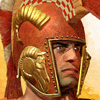HOME | DD
 ChrisHistoryartworks — Ancient German Warrior (1st Cent.bc)
ChrisHistoryartworks — Ancient German Warrior (1st Cent.bc)

#ancient #barbarian #cavalry #cloak #gaul #german #history #horse #illustration #military #rome #war #warrior #gallicwars #historyart #javellins #barbarians #caesar #europeanhistory #germany #historical #militaryuniform #raider #shield #warriors #barbarianwarrior #illustrationdigital
Published: 2021-05-25 19:28:41 +0000 UTC; Views: 12568; Favourites: 130; Downloads: 0
Redirect to original
Description
Roman sense of geography for lands north of Rhine and Danube was fuzy before Caesar’s expeditions and this factor made any effort to distinguish the Germanic peoples from northern Celts or other neighbouring pre Indo-European peoples, rather difficult. Somehow the Roman perception of north – eastern European geography remained fuzy even after military expeditions in imperial times. Anyway, Germans posed a serious threat both for Romans and Galatian Celts in the middle 1st century BC and the German raids served Caesar’s ambitions extremely well when used them as a pretext to incorporate reach Gaul to the Roman world, considering “Gallia” as a weak neighbor, a multi-tribal state country without political unity ready to fall to German invaders and become a base for further invasions in Italy. In general, early Roman references to Germanic warriors (Julius Caesar, Cornelius Tacitus, Cicero) describe many of them as riding ugly hairy horses, poorly equipped in iron and cloth, very intimidating in battle making the “baritus” a distinctive war cry by shouting behind their shields, being more blonde and taller than Celts.
The depicted German warrior bears a distinctive upstanding pony tail hair style, carries javelins (looted by killed Celts) and a Celtic style oval cavalry shield decorated with crescent moon and star symbols (very popular shield blazon to Germans and Celts). The possession of bronze “phalera” disks on his horse harness, the use of embroidered saddle cloth, leather laced shoes, iron weapons and the massive cloak adorned with fur, denotes this man as important leader who owns much spoils of war. German weaponry would much improved in decades to follow through raiding and mercenary activities…
Commissioned artwork (2014)published in Italy-©Copyright: Christos Giannopoulos
Related content
Comments: 2

👍: 1 ⏩: 1

👍: 0 ⏩: 0

















